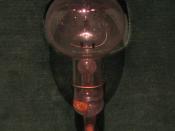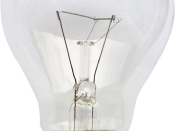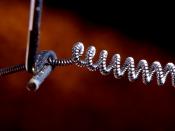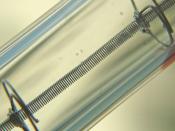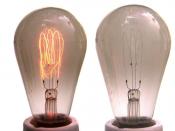5/2/2006
Aim: Does the resistance of a filament bulb change as the bulb gets brighter?
Hypothesis: I believe that a filament bulb will have an increasing resistance depending upon the current passing through it.
Equipment:
*Power Supply
*Wires
*Ammeter
*Voltmeter
*Filament bulb with holder
*Alligator clips
*Switch
Method:
1.Set up the circuit according to the schematic diagram
2.Use the alligator clips to connect the filament bulb to the voltmeter
3.Connect the power supply to the electricity
4.Make sure the switch is closed.
5.Measure and note down the temperature of the bulb with the thermometer
6.Turn on the power of the power supply
7.Measure down the P.D (v) and Current (a) and the temperature as you increase by .50 each time until 4.50 volts
Diagram:
Variables:
Controlled Variables: Filament bulb of the same type
Independent Variables: Voltage
Dependant Variable: Current (that is what was measured due to the voltage change), Temperature (increased as bulb got brighter)
Results:
P.D. voltage
(v)Trial 1 Current (a)Trial 2 Current (a)Average Current (a)Trial 1
Temperature
(Celsius) Trial 2
Temperature
(Celsius) Average
Temperature (Celsius)Bulb Brightness
(scale 0-10)
0000202020Off
0.50.060.060.06202020
10.090.080.08520.320.520.4
1.50.10.10.120.520.520.5
20.120.120.122121.221.1
2.50.140.140.1421.521.521.5
30.160.160.16232323
3.50.170.170.1723.523.523.5
40.190.180.18524.22424.1
4.50.20.20.2252525
Analysis
I plotted my information on a graph with the P.D. on the Y axis and the Current on the X axis. In this way the slope of the graph is the resistance of the bulb. Looking at my graph I decided that there are thee separate lines that could approximate the graph. The slope of these three lines gives 3 different resistance values for the filament bulb. The resistance of the bulb increases as the current through the bulb increases. From the information of my table from my results I notice that the temperature increase corresponds with the increase in the current passing through the bulb.
My explanation why the resistance change is that as the bulb has more current passing through it, this makes it hotter. This affects the filament molecules which a vibrating at a faster rate taking up more space. This increases the resistance of the bulb since the current has more obstacles in its way.
Conclusion
My hypothesis is correct my resistance changed due to the current passing through the filament bulb. Specifically I could find three regions of resistance in my graph. R1=8.33⦠, R2=25â¦, R3=33.33â¦.
Evaluation
A way to improve this experiment would be to have more data points and increase the voltage by smaller amounts. This would make my graph more accurate in finding the slope. A way that this experiment could be extended is by using different types of filament light bulbs that have different settings for different voltage. I could also increase the potential difference passing through the bulb as an extension. Another way to determine the relationship of the temperature is to heat the bulb in a different matter such as in a oven and seeing how the temperature relates to the resistance.
